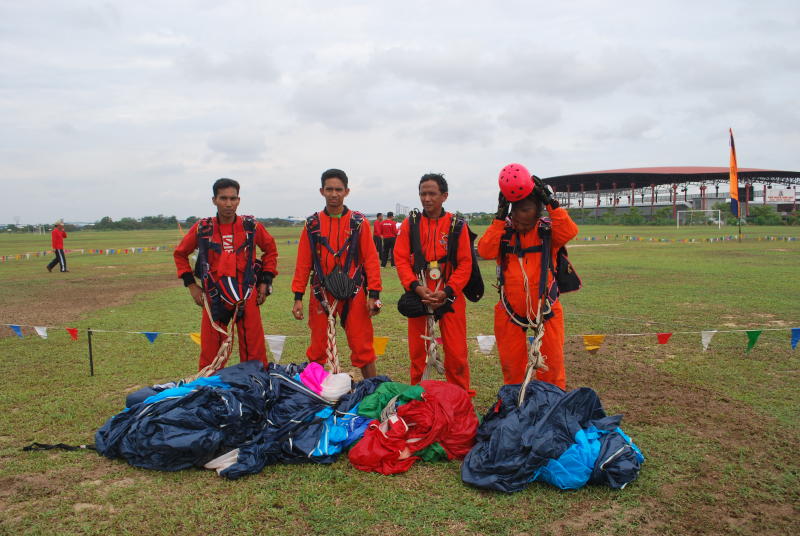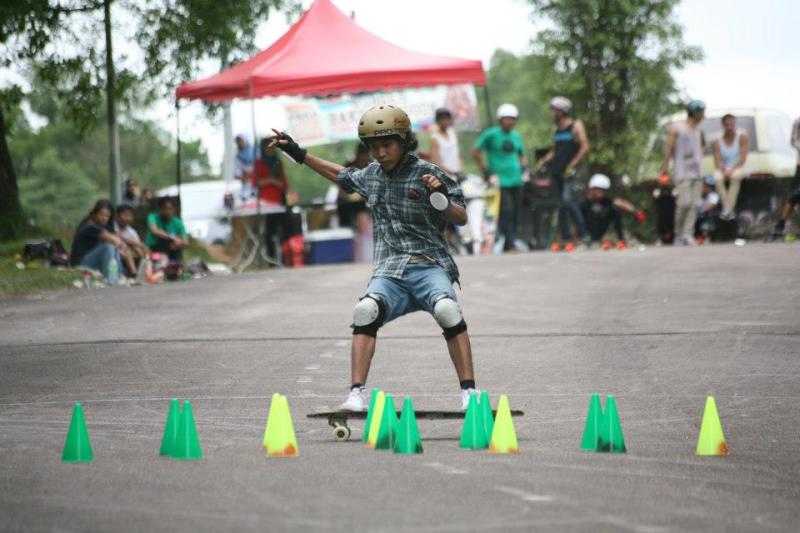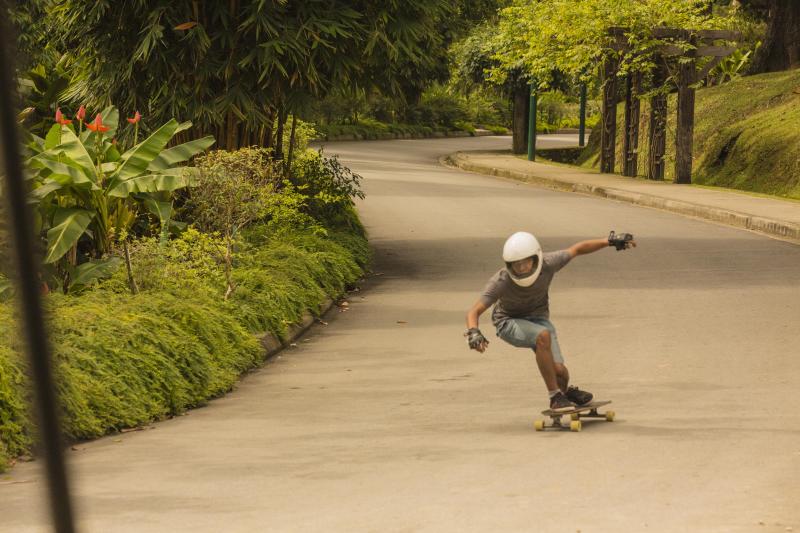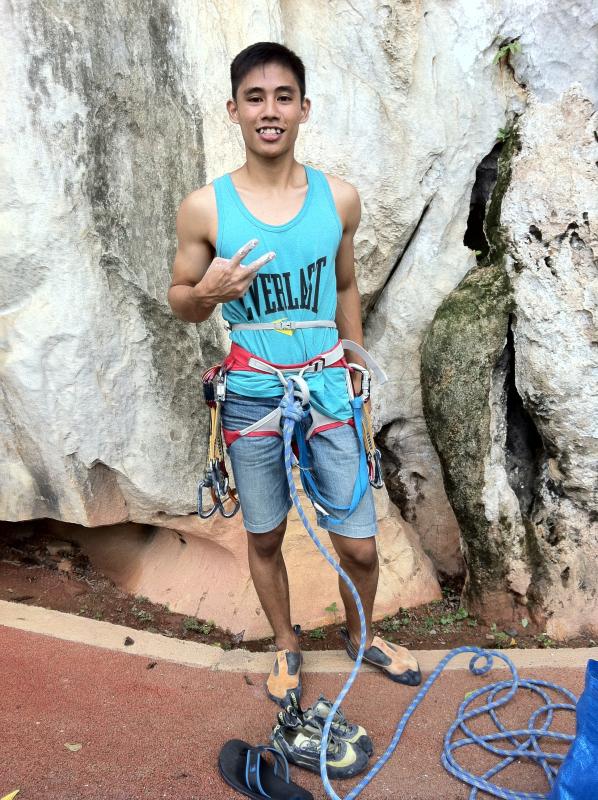By CHRISTINE CHEAH
alltherage@thestar.com.my
IN a world where most young people are happy to spend all their free time behind computers or maybe break a tiny sweat playing parent-friendly futsal, there are some daredevil youths who’d rather chase a quick thrill than a ball.
They jump off tall buildings with hopes that the parachute works, defy gravity and climb insanely high altitudes, feel the wind in their face as they zip down steep slopes on a tiny board and more importantly, feel alive with the adrenaline rush that no amount of touch screen-fiddling could ever bring.
Well, aren’t we lucky then to be able to catch some of these up-and-coming extreme sports enthusiasts with their feet firmly on the ground and not doing some crazy stunts else where.
Flying without wings

Some people regard BASE jumping as a dangerous sport but that is not going to stop Haziq Azlan, 25, from chasing the thrill he gets every time he makes a jump.
BASE (which stands for building, antenna, span and earth) jumping is a sport where participants jump from a high altitude (usually tall buildings or towers) and break the fall using a parachute.
It is considered dangerous because the “fall” usually has a shorter distance compared to skydiving and is affected by wind conditions as well.
During R.AGE’s visit to the Gua Damai BASE Jump event in Batu Caves, Kuala Lumpur a few weeks ago, one of the BASE jumpers’ parachute got caught in a tree but thankfully, the jumper survived the fall.
“It takes less than a minute to do a BASE jump but anything can happen in a split second. The timing to release the parachute, body position, gears, wind condition must all be right at that time,” said Haziq who is also a full-time skydiving instructor. “You only have seconds to think about what to do next because a minor mistake can be fatal.”
Haziq, who started doing tandem skydiving since he was 10, obtained his skydiving instructor’s license at 22.
“You need to be a skydiver to be a BASE jumper. I’ve met people who come to me and say they want to BASE jump but for safety reasons, I would just advise them to take up skydiving first,” he said.
Haziq’s interest in skydiving and BASE jumping was instilled by his father – who was the first civilian to skydive back in 1980 and is considered one of the pioneers in the skydiving industry in the country.
However, his father had to retire from BASE jumping after breaking his leg in his last jump.
“Skydiving runs in the family. My parents allow me to skydive but they don’t encourage me to BASE jump because they know the dangers of the sport,” said the legal studies graduate from UiTM Shah Alam.
Fortunately, Haziq has not had any serious injuries but nevertheless, the fear of something going awry during BASE jumping is always in his mind.
“The fear will always be inside me but skydiving teaches me to gradually overcome it. For every jump I make, I check my gears over and over again because they have to be in perfect condition,” shared
Nowadays, Haziq travels around the country to BASE jump and even conducts skydiving classes during the weekends.
And when asked if he wants to pursue a legal career some day, he said: “I might have to eventually but so far, I’m living a life I want. So let’s keep it this way for the time being.”
Catch me if you can
While some people are still finding ways to balance themselves on a skateboard and skate on flat land, Adam Akmal, 23, has already mastered longboarding, zipping downhill on a longer piece of board, at a higher speed and feeling more thrill than one could imagine.
To put it simply, longboarding is the same as skateboarding, except that it’s done on a longer (and slightly wider) board, hence its name.
TFY Skate president Adam has been longboarding since 2010 and even placed third at the Talegong Longboard Festival in Indonesia two months ago.
Like most extreme sports, longboarding has its dangers which is why safety is of utmost importance. Longboarders are required to wear safety equipment such as helmet and pads to minimise injury and even potentially save their lives if any unfortunate accidents were to happen.
“It’s scary but you just have to focus while riding,” said Adam who wears full gear whenever he goes for his longboarding sessions. “I guess I just like the excitement and thrill of it.”
The longboarding scene has grown steadily in Malaysia since 2010 and the first unofficial international longboarding competition was held in Kuantan, Pahang two years ago.
“We had skaters from Johor, Terengganu and Singapore who came to compete,” he said. Although the sport is still considered relatively new here, Malaysia has already produced one of the top female longboarders in the world, Ching Ho.
The 27-year-old is one of the pioneers in the local longboarding scene, and is known for helping to bring the scene to an international level.
“Ching’s an amazing skater. She helped build the community here and taught us a lot of things,” said Adam who is currently pursuing a mass communication degree at SEGi University.
Adam and his friends had initially planned to organise a longboarding festival as a farewell present for Ho (who was moving to Canada), but after getting the government’s support, their Rimba Alam Downhill Jam in June became the country’s first official longboarding competition instead.
“I want to share my passion for longboarding with more people in Malaysia and hopefully make it a viable way of transportation,” he said.
Top of the world
Taqiuddin Mohd Zulkifli may have only started rock climbing two years ago, but he already has his eyes set on becoming one of the top indoor rock climbers in the world.
“I want to represent Malaysia for indoor rock climbing and hopefully enter the finals in the World Cup in five to six years,” said the 19-year-old climber.
Like most climbers, Taqiuddin’s venture into the sport started from doing top-rope climbing (where a climber attaches himself to one end of a rope, which passes through an anchor at the top of the wall, and down to a partner who belays the climber.).
“It started when my cousin invited me to climb top rope in Shah Alam and I fell in love with it,” said Taqiuddin who is now known for lead climbing and bouldering.
Lead climbing differs from top-roping whereby the climber does not have an anchor point above them whilst climbing. They clip their ropes onto the wall as they climb, which is more dangerous and mentally challenging.
Bouldering on the other hand is a form of rock climbing without the use of ropes or harnesses.
Taqiuddin acknowledges the danger which this extreme sport presents, which is why he always prioritises safety during each session.
“I am still afraid of outdoor climbing, especially if it’s on a slack wall because if I fall, I’d hit the wall,” he said.
Nevertheless, Taqiuddin has managed to avoid major accidents thanks to his strict safety measures.
Taqiuddin’s love for the outdoors was cultivated by his parents who also lead active lifestyles.
“My dad is a scuba diver. He also does spear fishing, super biking, golfing and bowling.
“I guess having supportive parents really helps me in pursuing my dream,” Taqiuddin said of his parents, who accompany him to his competitions around Malaysia.
Although Taqiuddin is currently pursuing a degree in engineering, his love and loyalty still lies with the extreme sport. He said, “If an engineering job pays me RM5,000 and climbing pays me RM3,000, I would choose climbing.”




Tell us what you think!